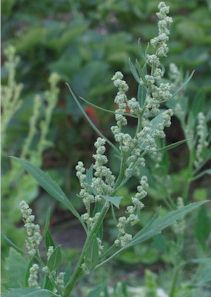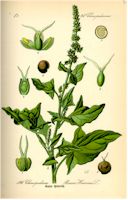|

Goosefoot |
Among Curative Simples, the Goosefoot, or Chenopod order of British plants, contributes two useful herbs, the Chenopodium bonus Henricus (Good King Henry), and the Chenopodium vulvaria (Stinking Goosefoot).
This tribe derives its distinctive title from the Greek words, cheen, a goose, and pous, a foot, in allusion to the resemblance borne by its leaves to the webbed members of that waddling bird which raw recruits are wont to bless for their irksome drill of the goose-step. Incidentally, it may be said that goosegrease, got from the roasted bird, is highly emollient, and very useful in clysters; it also proves easily emetic.
The Goosefoot herbs are common weeds in most temperate climates, and grow chiefly in salt marshes, or on the seashore. Other plants of this tribe are esculent vegetables, as the Spinach, Beet, and Orach. They all afford "soda" in abundance. |
The "Good King Henry" (Goosefoot) grows abundantly in waste places near villages, being a dark green, succulent plant, about a foot high, with thickish arrow-shaped leaves, which are cooked as spinach, especially in Lincolnshire. It is sometimes called Blite, from the Greek bliton, insipid; and, as Evelyn says, in his Acetaria, "it is well named, being insipid enough."
Why the said Goosefoot has been named "Good King Henry," or, "Good King Harry," is a disputed point. A French writer declares "this humble plant which grows on our plains without culture will confer a more lasting duration on the memory of "Henri Quatre" than the statue of bronze placed on the Pont Neuf, though fenced with iron, and guarded by soldiers." Dodoeus says the appellation was given to distinguish |

Good King Henry |
the plant from another, a poisonous one, called "Malus Henricus", "Bad Henry." Other authors have referred it to our Harry the Eighth, and his sore legs, for which the leaves were applied as a remedy; but this idea does not seem of probable correctness. Frowde tells us "the constant irritation of his festering legs made his terrible temper still more dreadful. Warned of his approaching dissolution; and consumed with the death-thirst, he called for a cup of white wine, and,
turning to one of his attendants; cried, 'All is lost!'--and these were his last words." The substantive title, Henricus, is more likely derived from "heinrich," an elf or goblin, as indicating certain magical virtues in the herb.
It is further known as English Marquery, or Mercury, and Tota bona; or, Allgood, the latter from a conceit of the rustics that it will cure all hurts; "wherefore the leaves are now a constant plaster among them for every green wound." It bears small flowers of sepals only, and is grown by cottagers as a pot herb. The young shoots peeled and boiled may be eaten as asparagus, and are gently laxative. The leaves are often made into broth, being applied also externally by
country folk to heal old ulcers; and the roots are given to sheep having a cough.
Both here and in Germany this Goosefoot is used for feeding poultry, and it has hence acquired the sobriquet of Fat-hen.
The term, English Mercury, has been given because of its excellent remedial qualities against indigestion, and bears out the proverb: "Be thou sick or whole, put Mercury in thy koole." Poultices made from the herb are applied to cleanse and heal chronic sores, which, as Gerard teaches, "they do scour and mundify." Certain writers associate it with our good King Henry the Sixth. There is made in America, from an allied plant, the oak-leaved Goosefoot (Chenopodium
glaucum), or from the aphis which infests it, a medicinal tincture used for expelling round worms.
|

Stinking Goosefoot |
The Stinking Goosefoot, called therefore, Vulvaria, and Garosmus, grows often on roadsides in England, and is known as Dog's Orach. It is of a dull, glaucous, or greyish-green aspect, and invested with a greasy mealiness which when touched exhales a very odious and enduring smell like that of stale salt fish, this being particularly attractive to dogs, though swine refuse the plant. It
has been found very useful in hysteria, the leaves being made into a conserve with sugar; or Dr. Fuller's famous Electuarium hystericum may be compounded by adding forty-eight drops of oil of amber (Oleum succini) to four ounces of the conserve. Then a piece of the size of a chestnut should be taken when needed, and repeated more or less often as required. It further promotes the monthly flow of women. But the herb is
possessed odoris virosi intolerabilis, of a stink which remains long on the hands after touching it. The whole plant is sprinkled over with the white, pellucid meal, and |
contains much "trimethylamine," together with osmazome, and nitrate of potash; also it gives off free ammonia. The title, Orach, given to the Stinking Goosefoot, a simple of a "most ancient, fish-like smell," and to others of the same tribe, is a corruption of aurum, gold, because their seeds were supposed to cure the ailment known popularly as the "yellow jaundice." These plants afford no nutriment, and, therefore, each bears the name, atriplex, not,
trephein, to nourish:
"Atriplicem tritum cum nitro, melle, et aceto Dicunt appositum calidum sedare podagram Ictericis dicitque Galenus tollere morbum Illius semen cum vino saepius haustum."
"With vinegar, honey, and salt, the Orach Made hot, and applied, cures a gouty attack; Whilst its seeds for the jaundice, if mingled with wine, --As Galen has said--are a remedy fine."
"Orach is cooling," writes Evelyn, "and allays the pituit humors." "Being set over the fire, neither this nor the lettuce needs any other water than their own moisture to boil them in." The Orach hails from Tartary, and is much esteemed in France. It was introduced about 1548.
Herb Simples
The Primitive Simplers presented here show the way of life in other generations, it is not suggested or recommended trying them yourself. |
|
Garden
Herbs
Home
History of Herbs
Herb Gardening
Herbs for Beginners
Drying & Preserving Herbs
Indoor Herb Gardening
Herb Garden
Hints & Tips
Herbal
Cooking
Herb Chart
Using Herbs
Culinary Herbs
Herb
Oil and Vinegar
Herb Teas
Herb Candy
Herb Jelly
Herb Simples
Preface
Introduction
Alphabetical Listing

Trade
Recipes Online
Share your Recipes with others!!
|




